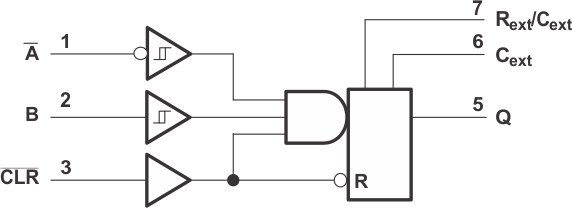SCES586E July 2004 – March 2024 SN74LVC1G123
PRODUCTION DATA
- 1
- 1 Features
- 2 Applications
- 3 Description
- 4 Pin Configuration and Functions
-
5 Specifications
- 5.1 Absolute Maximum Ratings
- 5.2 ESD Ratings
- 5.3 Recommended Operating Conditions
- 5.4 Thermal Information
- 5.5 Electrical Characteristics
- 5.6 Timing Requirements
- 5.7 Switching Characteristics, CL = 15 pF, –40°C to 85°C
- 5.8 Switching Characteristics, CL = 50 pF, –40°C to 85°C
- 5.9 Switching Characteristics, CL = 50 pF, –40°C to 125°C
- 5.10 Operating Characteristics
- 5.11 Typical Characteristics
- 6 Parameter Measurement Information
- 7 Detailed Description
- 8 Application and Implementation
- 9 Power Supply Recommendations
- 10Layout
- 11Device and Documentation Support
- 12Revision History
- 13Mechanical, Packaging, and Orderable Information
Package Options
Mechanical Data (Package|Pins)
Thermal pad, mechanical data (Package|Pins)
Orderable Information
3 Description
The SN74LVC1G123 device is a single retriggerable monostable multivibrator designed for 1.65V to 5.5V VCC operation.
This monostable multivibrator features output pulse-duration control by three methods. In the first method, the A input is low, and the B input goes high. In the second method, the B input is high, and the A input goes low. In the third method, the A input is low, the B input is high, and the clear ( CLR) input goes high.
The output pulse duration is programmed by selecting external resistance and capacitance values. The external timing capacitor must be connected between Cext and Rext/Cext (positive) and an external resistor connected between Rext/Cext and VCC. To obtain variable pulse durations, connect an external variable resistance between Rext/Cext and VCC. The output pulse duration also can be reduced by taking CLR low.
Pulse triggering occurs at a particular voltage level and is not directly related to the transition time of the input pulse. The A and B inputs have Schmitt triggers with sufficient hysteresis to handle slow input transition rates with jitter-free triggering at the outputs.
| PART NUMBER | PACKAGE (1) | BODY SIZE (NOM) |
|---|---|---|
| SN74LVC1G123 | SSOP (8) | 2.95mm × 2.80mm |
| VSSOP (8) | 2.30mm × 2.00mm | |
| DSBGA (8) | 1.91mm × 0.91mm |
 Logic Diagram (Positive Logic)
Logic Diagram (Positive Logic)